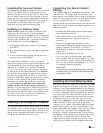
8
YY
YY
Y
English
L-2448B Installation
Seawater Pump
Centrifugal pumps are not self-priming, and must be
mounted so that they are below the heeled waterline in
any given operating condition. The pump should be
accessible for future service.
Mount the pump so that the outlet is directed upward.
The head on some pumps can be rotated to allow
mounting on a vertical bulkhead, see Figure 8. Self-
priming pumps are available if the pump cannot be
mounted below the waterline.
Required Seawater Flow Rate
The Dometic ice maker requires 2.5 GPM or 150 GPH
of seawater flow for rated performance.
Manifolds
If a pump is serving multiple units, then a seawater
manifold will be needed to supply water to all units.
This can be as simple as a tee for two units, or a
custom manifold for seven to eight units.
It is very important to consider manifold orientation so
that all units get their required flow. See Figure 9 for
proper orientation tips.
A manifold can also be used on the outlets of the
units when using a single overboard discharge.
Overboard Discharge
The overboard discharge should be located between 1
and 2 inches (25-50 cm) above the waterline. This is to
facilitate visual confirmation of water flow, but also to
keep it close to the waterline to minimize splashing.
If the overboard is located below the waterline, then a
valve must be installed per ABYC guidelines.
Seawater Piping
• Only use reinforced marine grade hose or other
suitable piping (PVC, CPVC, cupronickel, or
stainless steel).
• Double clamp all hose connections.
• Use only plastic, bronze, or stainless steel fittings
(do not use brass).
• Avoid loops or dips in all hose runs.
• Make sure enough hose is used to allow for future
removal of components.
• Use the correct size hose, fittings, and compo-
nents. See Figure 9 for proper sizing.
Note that the
pump inlet piping (including through-hull and
strainer) may need to be larger than the outlet pipe
size. Do not use pump connections to determine
hose size.
• The “pump inlet” recommended pipe size includes
all fittings and hose up to the pump connection
(through-hull, seacock, strainer, hose, manifold).
The “pump discharge” recommended pipe size
includes all fittings and hose from the pump
discharge up to the overboard discharge.
Bonding
Bond all metallic parts (through-hull, valves, strainer,
manifolds, etc.) that are in contact with seawater to
the vessels’ bonding system in accordance with ABYC
standards. Items should only be bonded or grounded
once. If an item is in contact with an electrically
grounded part (pump, seawater condenser) then it
should not be bonded again.
Pump Relay
The pump relay is generally located in the engine room
or mechanical space near the seawater pump, but can
be mounted anywhere that is convenient and acces-
sible. It must be in a dry location, away from water
spray, with some room for heat dissipation.
Choose your pump relay based on the number of units
that will be operating off one pump. Choose each
trigger to reflect the voltage of the unit it serves. The
polarity of the signal from the unit does not matter to
the trigger, but the voltage is very important.
Installing the Control Panel
The control panel may be installed wherever desired,
however, it may not be exposed to saltwater spray. The
panel comes with a plug on the back. Use extension
cables (purchased separately) to run between the panel
and the control box. They may be extended up to 100'.
Use the cutout dimensions provided in Figure 10.
Route cable to control box on condensing unit, and
plug into the mating connector.


















